Calisthenics is a training method that focuses on the use of one’s own body weight as resistance in different exercises. These usually involves large muscle groups and allow the athlete to gain incredible strength and control over their own body.
Historical Background
The use of exercises with body weight and the search for perfection in the movement, dates back to the times of Greek and Roman history (Spartans, gladiators, soldiers …) long before becoming competitive sports with the foundation of artistic gymnastics in 1881, or even before its appearance and diffusion in France at the hands of Phokion Heinrich Clias in 1822. We can even find the use of body weight focused on training going back to Asian culture, where we find examples like the Shaolin monks of China.
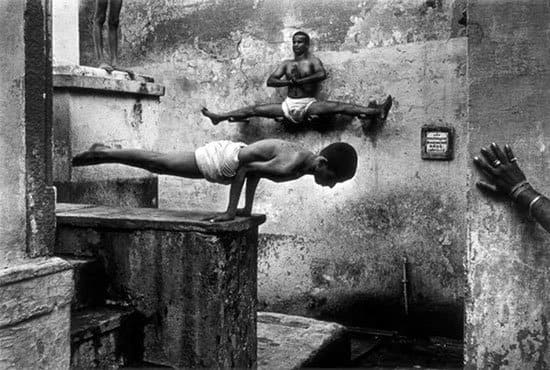
The vestiges of the Greek era show us how King Minos gave support and encouragement to the realization of physical exercise. In ancient Greece, this type of training was given the name of Calisthenics, a name that has lasted until today.
The word Calisthenics, as we have commented previously, comes from the Greek, kallos (beauty) and sthenos (strength), in turn related to the word gumnos (naked), from which the term gymnastics comes.
‘Beauty, Strength, Nude’: the three pillars of Calisthenics in ancient times. The use of the strength applied to the movement, in search of beauty, without more than with the body itself. Three words that perfectly define this sport.
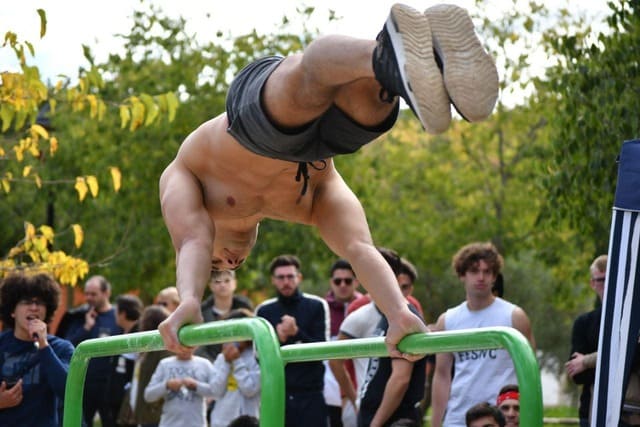
The Calisthenics or Street Workout is a sport and a social movement based on the exercise of the body through the body weight itself following a healthy lifestyle. This discipline is based on positive values such as respect, education, equality, social integration and help among its members. Without political, religious or economic contextualities, Street Workout is for everyone, regardless of age, sex, ethnicity or physical level of people.
This sport that can be practiced in the street, outdoors or where desired, and today, due to the economic situation that many countries are going through, people who do not want or cannot spend money in gyms, can use it to work out for free.
It is in the late 80s, early 90s, when the revolution of this sports movement begins in the streets of Brooklyn when African-American men competed to see who was the strongest using their urban environment in parks or public squares. The street lamps, bars and the ground were used as if they were a large gym on the street.
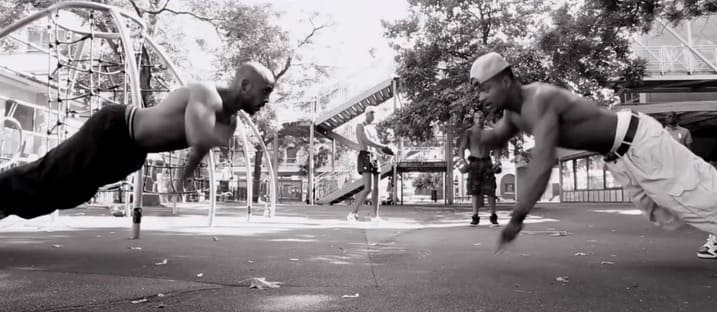
But we will have to wait until 2005 to see Street Workout as we know it now. From Brooklyn and New York, exponential growth has emerged in recent years thanks to groups organized in the United States such as Ruff Ryders and Bartendaz. This last group begins in a pioneer way to incorporate into their ranks people at risk of social exclusion, offering them healthy motivations and aspirations that separate them from a life relegated to ostracism.
This movement has a lot of potential to help all these young and not so young people, when they carry out their activity fundamentally in public places, accessible to all, as it does not imply an economic expense and, above all, due to their group character, which allows developing values as important as companionship, effort, integration, respect, tolerance, self-esteem, discipline, etc…
More specifically, in the Bronx neighborhood in New York, it is where the members of this group train every day with many young people of different ethnicities and different social situations, helping them to live day by day thanks to the friendship and the bonds that are formed. In training, the enthusiasm and motivation to go every day to overcome each exercise they learn, getting a healthy lifestyle habit both physically and mentally.
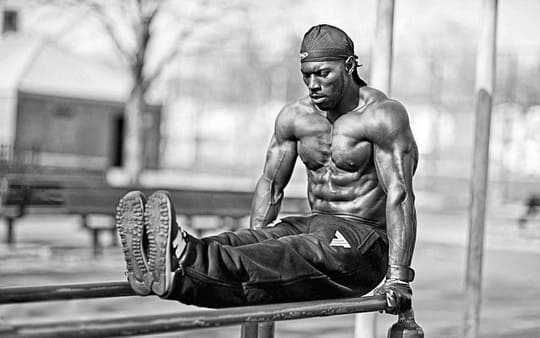
But the ‘boom’ of this sport begins around 2008 indirectly thanks to athletes such as Hannibal for King or Zef Zakavelli and the use of new social networks or video platforms such as YouTube, through which exercise videos were uploaded on the street, with some called “Thug Workout or Ghetto Workout” (since gangsters practiced it) (Pioneer group in street training, but without any social background). Videos of Bartendaz also appeared and would also collect this philosophy of healthy and non-problematic life. Defining it in 3 words: CAP COMMUNITY, ATTITUDE AND PERSONALITY. (Community, attitude and personality).
This caused this discipline to cross the borders of the United States and spread throughout Europe. Little by little, new movements of sports gymnastics, parkour and many other sports begin to be introduced, mixing everything and adding creativity and innovation, performing the exercises to the rhythm of music …
All this drives the arrival of the brand Name or the brand: Street Workout, with the first world championship in 2011.
In Europe, and more specifically in the east, the broad gymnastic tradition existing in countries such as Russia, Ukraine and the Czech Republic, since the former USSR, made clear the use of this sports discipline, Street Workout and Calisthenics.
Whether it was because of the belief of the possibility of war conflicts or because of the great qualities of their athletes in high competition, they made it possible for the streets of these countries for a long time to have good installations of fixed bars, parallel bars, low bars, rings, etc…
The good aptitude of urban athletes who use these structures, added to the fact that in many cases they have been trained since childhood by performing workouts with their own body weight (dominated, push-ups, bottoms, verticals, etc.) since they go to school, makes Street Workout and Calisthenics an inherent tradition in these countries.
For this reason, they start to stand out quickly. They begin to create a school with their own style and movements where the strength of their static exercises stands out, such as: irons, front levers, human flags …
Some examples of the best known athletes are: Adam Raw, Vladimir Sadkov, Dimitri Kuznetsov, Nikita Anisimov, Lada Pridal, among others.
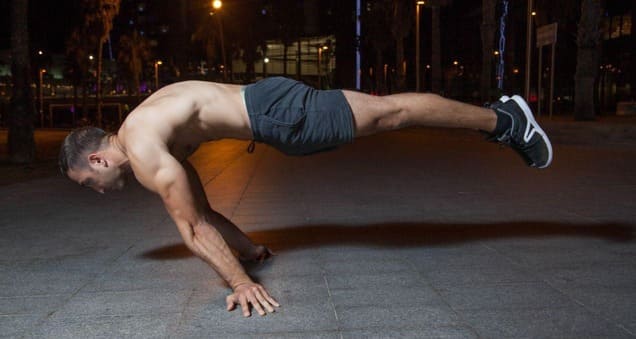
Calisthenics nowadays
The socio-sports concept of Street Workout and Calisthenics, begins to be introduced in 2010 thanks to sports groups or groups of young people that begin to emerge and practice this discipline throughout the national territory. This is due to the rise of this sport modality worldwide, becoming a sport and viral phenomenon in social networks.
The sporting level grew faster than expected, also leading to a growth in the attitude of social collaboration. Projects, events, works with the municipalities, collaborations with social associations, talks, exhibitions, and even championships were created. All this led to many members becoming interested in work areas that would otherwise have been beyond their reach: learn to plan events, deal with public entities, assemble and edit videos, begin to gain experience as Street Workout monitors collaborating in youth institutes or associations, etc…
The power of this sport is unstoppable and all teams have taken their own the social part of this discipline in their ideals and daily goals. There are groups throughout Spain, largely made up of boys and girls with a high risk of social exclusion, learning profit values, working in teams, acquiring responsibilities and creating healthy habits that will help them a lot in their lives.
Typical Calisthenics exercises
As we mentioned earlier, Calisthenics uses our own body weight as resistance for the exercises. There is a wide variety of exercises that range from beginner level to more advanced profiles in this sport.
In this section we will mention some of the most important exercises starting from the most basic to the most advanced. If you want to see a complete list with photos and video of the Calisthenics exercises separated by categories and muscle groups you can do it in our Calisthenics exercises list.
Basic and fundamental exercises in Calisthenics:
As in all sports, there are a series of fundamental exercises that must be mastered in order to access those with more difficulty. In the case of Calisthenics, basic exercises are the following.
– The Pull Ups: in a horizontal bar, it consists of lifting your body from a hanging position until passing the chin over the bar.
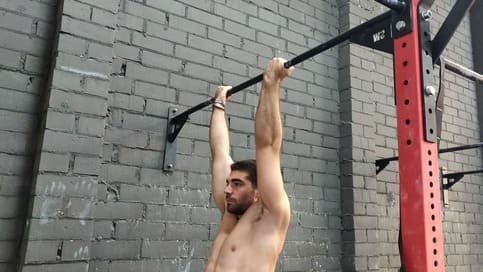
Pull Up Part
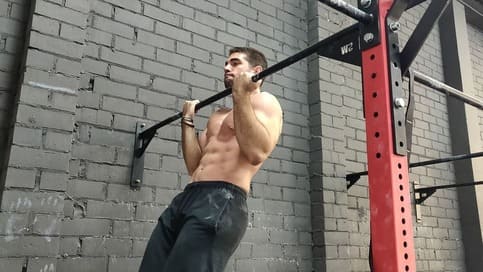
Upper Pull Up Part
– The Triceps Dips: in parallel bars, it consists of lowering the body by bending the arms until the arm breaks the horizontal and back up using only the strength of arms.
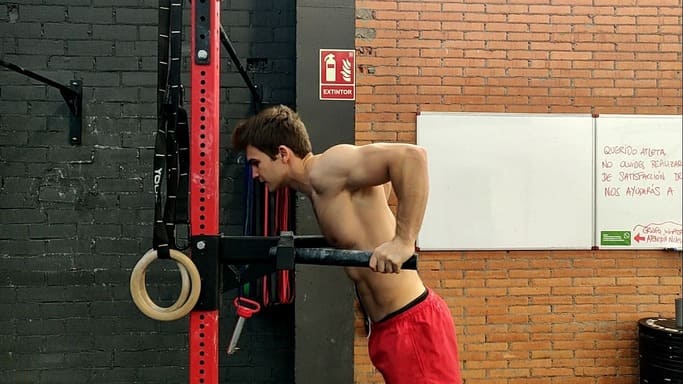
Lower Dip Part
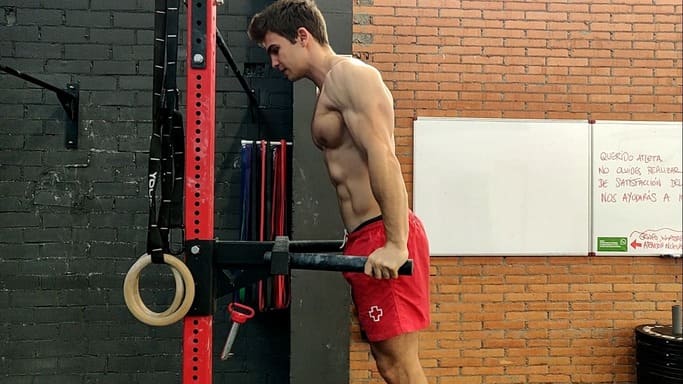
Upper Dip Part
– Push Ups: It starts facing down with arms extended and consists of lowering and lifting the bodyweight only with the arms.
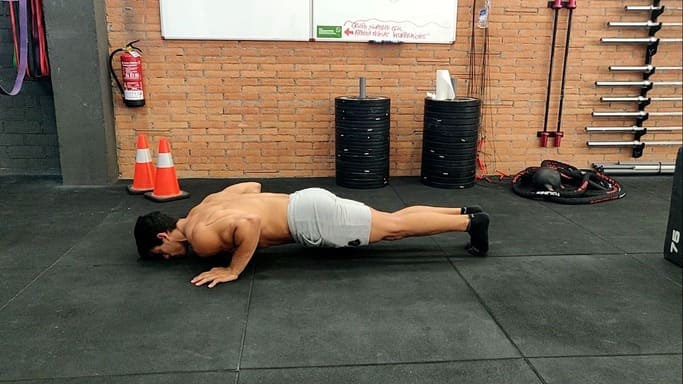
Push Up Lower Position
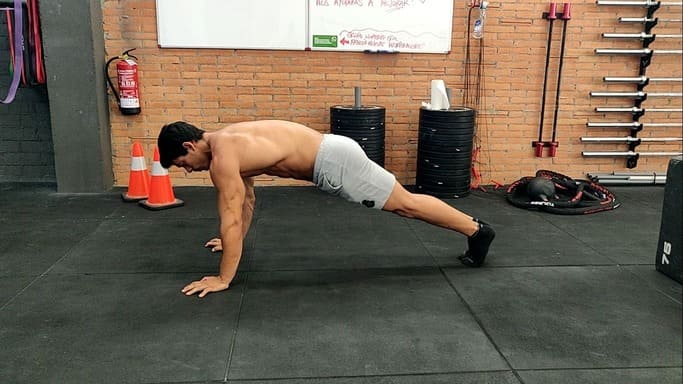
Push Up Upper Position
Other very important exercises of more difficulty:
– The Muscle Ups: in a bar or rings, combination of pull up and triceps dips in order to raise the body to the top of the bar or rings.
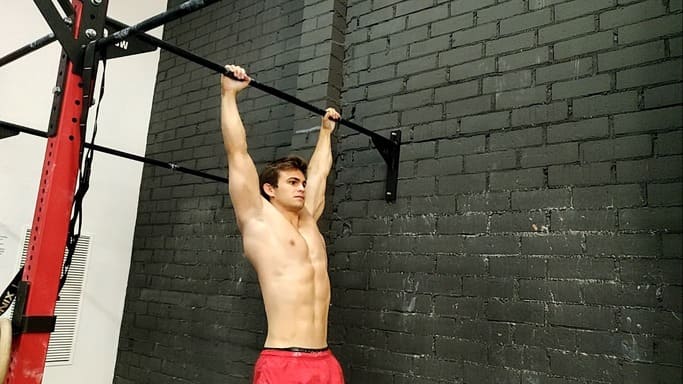
Muscle Up Lower Position
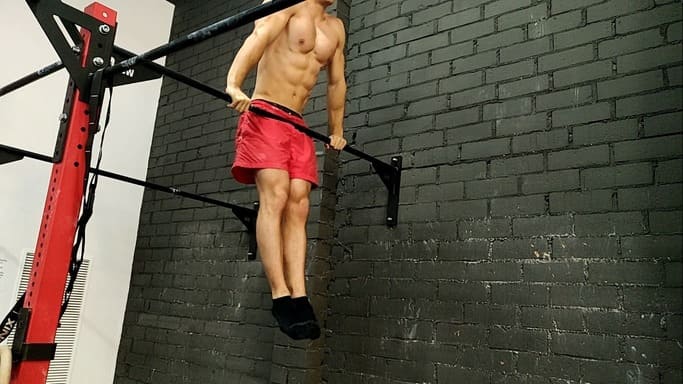
Muscle Up Upper Position
– The Handstand: consists of supporting the body in a stable, inverted vertical position by balancing on the hands.

– Isometric exercises: exercises such as planches, flags or other elements.
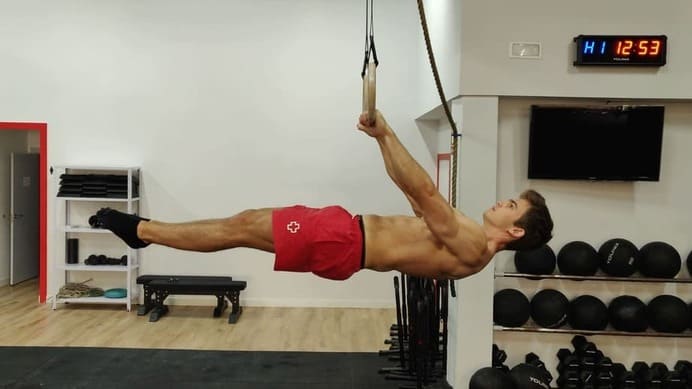
Front Lever
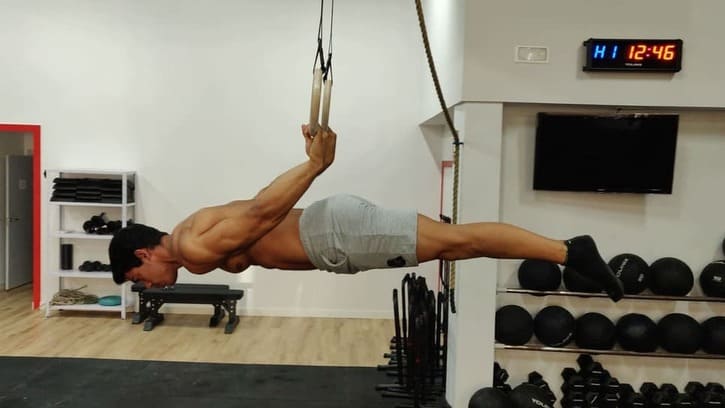
Back Lever
Calisthenics Disciplines
Since the beginning of Street Workout or Calisthenics, new disciplines focused on various types of training have appeared. Today we can differentiate 5 different disciplines:
Freestyle Discipline
The most practiced and popular, due to its visual appeal, consists of executing dynamic (pirouettes, flips…) and static (isometric) elements during a certain time. During this time the athletes have to show the judges their skills and strength and the winner is determined by the difficulty and beauty of the exercises.
In competitions this discipline is applied in 1-vs-1 battles where the athletes are being eliminated one by one or in individual format, where each athlete receives a score for its performance.
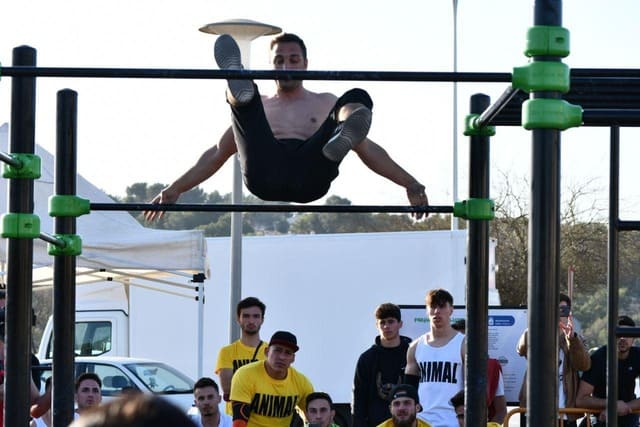
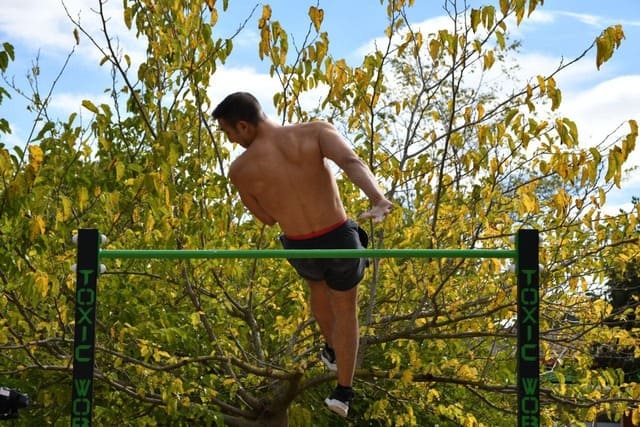
Strength Discipline:
This discipline is divided into two, the strength-resistance and the maximum strength or Street Lifting. Both focus on the basic exercises of Calisthenics such as pull ups, triceps dips, muscle ups and squats.
Strength-resistance consists in executing the maximum number of repetitions of each exercise with a determined extra weight. Each test is done once and there is a rest of more than 10 minutes between exercises. Typical extra added weights for each exercise are:
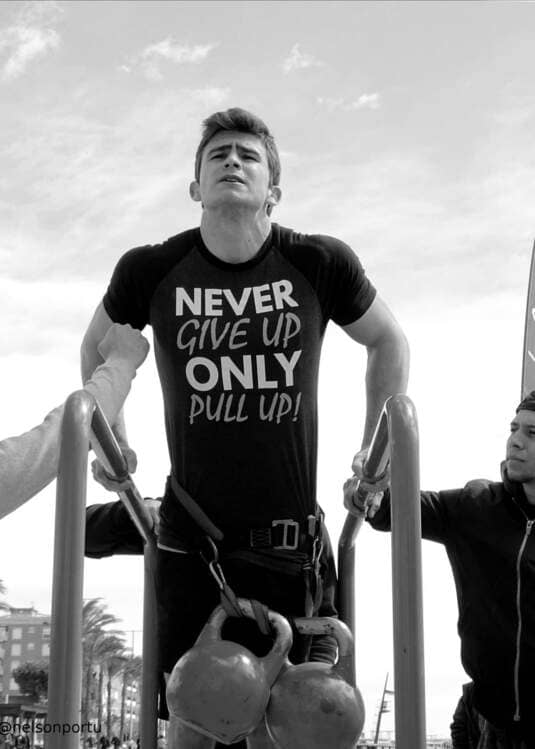
32 kg for pull ups (40 kg in more advanced competitions)
48 kg for triceps dips (60kg in more advanced competitions)
12 kg for muscle ups
52 kg for squats (100kg-120kg in more advanced competitions)
In competitions, the classification is given by adding the total number of repetitions or classifying the competitors for each test separately.
Maximum strength or Street Lifting is a discipline that is becoming very popular around the world. It consists of lifting the maximum possible weight in 3 attempts for each exercise, as in sports such as Powerlifting or Weightlifting.
The exercises are pull ups, muscle up, dips and squats. It is very important to maintain a good technique during the execution of each exercise.
In competitions, the judges determine whether the lift is valid or not and the winner is given by adding the maximum weight achieved for each exercise.
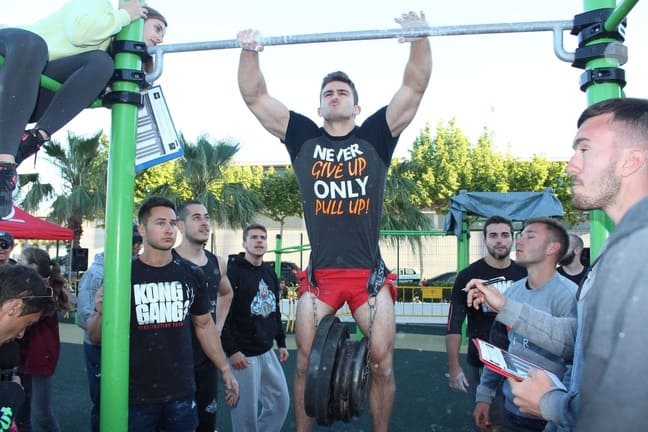
Resistance discipline

This discipline, like strength, focuses on the basic exercises of the Calisthenics. As the name implies, it consists of executing the maximum name of repetitions for each exercise without additional or little extra weight. The rest between exercises is usually very little or zero.
In competitions two types of formats are used:
The 1-vs-1 battles where athletes have to complete a sets of exercises and repetitions in the shortest possible time. Competitors are eliminated until the final battle is reached, where the winner is decided.
The individual series, where the number of repetitions is added for each exercise without rest between them.
Statics Discipline
This discipline consists of holding 3 static exercises for as long as possible with a rest of more than 10 minutes between tests. The elements are the straddle planche, the front lever and the human flag.
In competition the winner is determined by adding the time held in each of the positions. The technique in the execution of the exercises must be very proper and strict.
Workout Style
Similar to the Freestyle but not as popular, it consists of executing static and dynamic elements following the rhythm of the music as if it were a choreography. Athletes can choose their music and costumes and prepare the show for the competition.
In competition, the judges give a score for each performance and the winner is given.